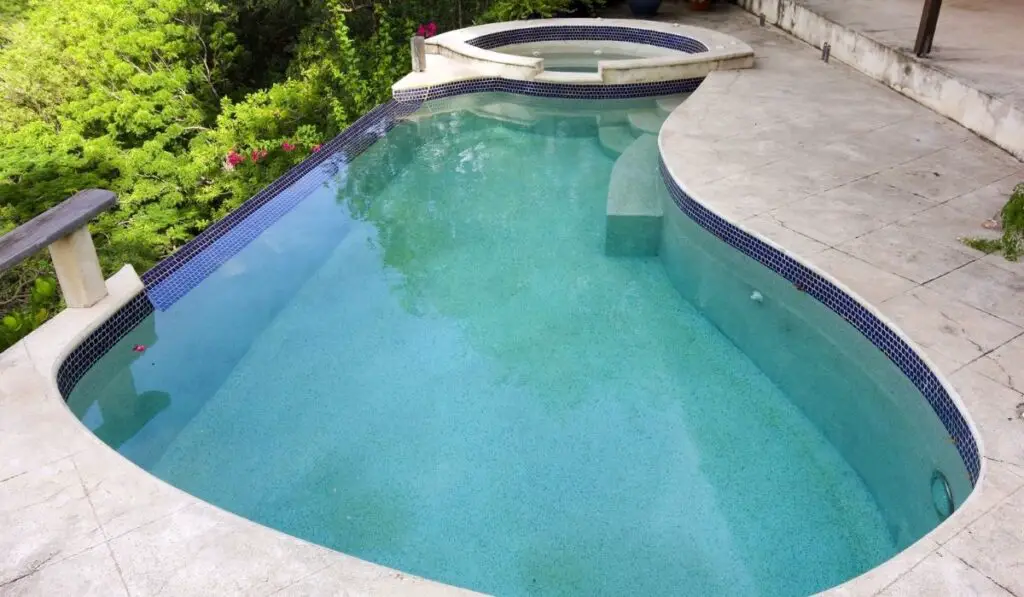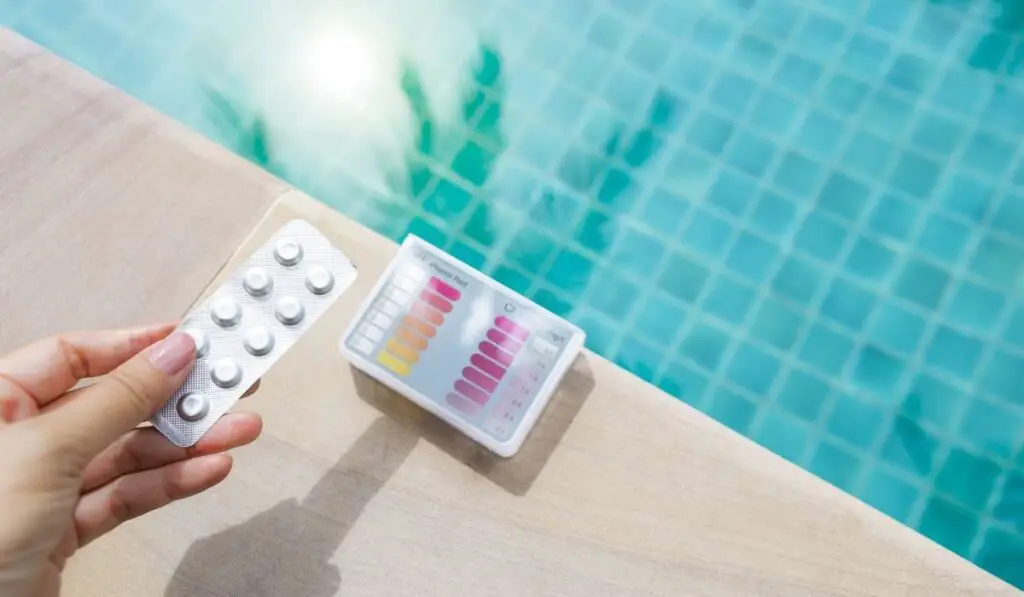If you have a swimming pool, you’ve probably experienced one of the most common pool problems — a cloudy appearance. Unfortunately, this color change can make the pool look extremely unappealing. So, what causes your pool to appear cloudy?
A pool may appear cloudy due to a chemical imbalance — especially high chlorine stabilizer levels — or a faulty filtration system. If bacterial control is lost, it will quickly go from cloudy to green. Clarifier or Flocculant may be required, but first balance the chemicals and see if that helps.
Let’s take a closer look at what causes a pool to look cloudy, how to address the problem, and some general maintenance tips for keeping your pool in tip-top shape throughout the year.
Why Does Your Pool Look Cloudy?

A swimming pool that isn’t well-maintained can cause the water to be cloudy and unpleasant to look at. This is especially true if your swimming pool is open all year round.
If you’re facing this problem, it could be due to one of the following factors.
Chlorine Levels
One of the most common reasons a swimming pool is cloudy is high chlorine levels. Especially with chlorine becoming so expensive, it’s easy to want to skip a few chlorine pucks (example on Amazon) to try and keep costs down.
Chlorine is used in swimming pools to disinfect & sanitize the water and kill bacteria and other microorganisms that can cause infections.
However, when the pool water has too much chlorine, it forms a chemical compound called chloramines, which causes it to become cloudy. This reaction happens when the chlorine combines with organic material in the water.
These chloramines are a health hazard and can cause eye irritation, skin rashes, and allergic reactions. That’s why it’s so important to test the concentration of chlorine in your pool before adding more.
You should, however, note that the amount of chlorine needed is also dependent on several other factors, including:
- The temperature of the water
- The number of people using the pool
- The amount of debris that accumulates in the bottom of the pool
If you own a saltwater pool, it is advisable to shock your pool manually rather than use the generator.
Imbalanced Chemicals
Beyond chlorine, other imbalanced chemicals are also a cause of pool cloudiness.
Calcium Levels
High calcium levels can make your swimming pool look cloudy. This is because calcium and other minerals are light and often stay suspended in the water.
High calcium levels can also lead to scaling on the pool’s walls and floors, making them rough and dull. They can also cause the walls in your pool to become slippery, which is dangerous for swimmers who can’t get out of the water quickly enough due to age or health issues.
Alkalinity
High alkalinity, combined with other factors such as high pH, low chlorine levels, and a lack of water movement, can cause a swimming pool to become cloudy. It causes cloudiness by releasing calcium and magnesium into the water. These two compounds then bond with the bicarbonate in your pool, giving the water an opaque appearance.
High alkalinity is caused by excessive use of baking soda or other alkaline chemicals in your pool.
Other Reasons You Pool Is Cloudy
If the chlorine levels are okay and all the chemicals are balanced, there’s a high chance that your pool has a cloudy appearance due to a faulty filter or the presence of algae.
Faulty Filter
A faulty pool filter can cause your swimming pool to be cloudy by letting dirt and debris get through the filter and back into the water. This problem could be caused by:
- A blocked filter: This might occur due to foreign objects such as leaves or other rubbish being caught in the filter. It could also be due to clogging of the sand in the cartridge or algae growing on the sand’s surface.
- A worn-out filter: This means that your filtration system needs replacing as it has reached its end life.
- Faulty plumbing: If your plumbing is faulty, then this might mean that debris can’t flow through into your pool properly. This could be caused by pipe leaks or loose connections between pipes and fittings that need tightening up before using them again.
- A dirty filter: The filter is designed to trap dirt and other contaminants that get into the water, but if it gets too full, it will stop working correctly. This can happen if you don’t clean it regularly or have neglected to replace the filter cartridge.
- A clogged drain: If your pool has a built-in drain at the bottom, make sure it is clear of debris and leaves that can clog it up.
- Incomplete circulation: Circulating water helps keep your pool clean and clear by distributing chemicals throughout the pool’s water column. If the circulation isn’t working correctly, these chemicals are unable to reach all areas of the swimming pool and are therefore ineffective at keeping your water clear and clean.
Algae
The most common type of algae in a residential pool is green algae, which grows on any surface that is wet or moist for extended periods, such as steps, ladders, and diving boards.
How to Clean a Cloudy Pool
The first thing you need to do is test both your chlorine and pH levels, using a pool chemical test kit (on Amazon). If they aren’t at their ideal levels — between 1-3ppm for chlorine and 7.2 – 7.8 for pH — then add more of the appropriate chemicals until your pool reaches its ideal level.
Then, it’s time for a bit of cleaning. First, give the walls and floor of your pool a good brushing with a long-handled brush (on Amazon). This will help eliminate any algae or mildew that might be hanging around in there.
You should then clean out your skimmers and filter basket so that no debris gets inside them while running later in the process. Finally, you need to backwash or clean the filter cartridge to ensure it’s clear before pumping water through again.
Now that everything is cleaned up and ready to go, it’s time to turn on the pump. For all those chemicals you added earlier and anything else floating around in there to be removed from your pool water, run your pump for 12 hours each day for three days straight.This will also help circulate enough air into the water, so it doesn’t turn cloudy again after it clears up.
Finally, you should add a clarifier (on Amazon) or flocculant (also on Amazon) into your pool water, at the doses recommended on the bottles. And you’ll probably need to know how many gallons your pool has to do all this properly, so start by calculating a rough figure for the volume of your pool.
Pool Maintenance Tips

As a pool owner, you should never compromise on keeping your pool clean. It’s the only way to ensure your pool stays healthy and safe for swimming. Here are some tips on how to maintain your swimming pool:
Keep the Water Clean
Cleaning the water is crucial as it prevents algae growth and bacteria from developing in your pool. Regular cleaning also keeps your water clear and safe for swimming.
Make sure you use a pool vacuum cleaner with a filtration system to remove dirt particles from the water. The filter should be cleaned regularly to remove dirt particles and prevent them from getting into the water when you turn on the pump again.
Clean Your Filters
Your filters should be cleaned regularly to maintain optimum performance. When you notice a decrease in pressure due to increased dirt or debris in your filters, clean them immediately before they get clogged up completely.
Regularly Check Chemical Levels
You must regularly check chemical levels to maintain optimum sanitization of your pool water. Make sure you test the pH, chlorine or bromine levels, total alkalinity, calcium hardness, and total dissolved solids (TDS) levels.
Test the pH Level
A pH balance of 7.2 to 7.8 is ideal for swimming, but if the reading is lower than 7, use a pool alkalizer (on Amazon) to raise the level. If it’s higher than 7, add more acid until you reach a neutral reading (pH 7).
Check Chlorine Levels
Do this daily by testing with a test kit. Chlorine levels shouldn’t be lower than two ppm or higher than four ppm. If you have too much chlorine in your pool, add muriatic acid (on Amazon) according to directions on the bottle and then retest after ~8 hrs of running the pump.
For chlorine levels, you should add liquid chlorine according to directions on the packaging and retest in 24 hours. If there is no change after adding two bottles each time (1 oz per 20 gallons), call an expert for help. Pucks can work, but they dissolve slowly, and you probably want some effects quickly if you’re trying to clear a cloudy pool.
Test Cyanuric Acid
Ensure you test the acid using a test strip every month. This chemical helps prevent algae growth without hurting humans or pets who come into contact with it, but if its concentration gets too high, it can cause eye irritation among swimmers.
